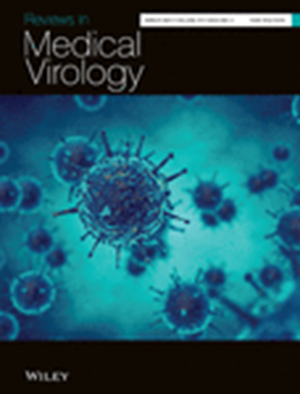人类乳头瘤病毒感染:流行病学、生物学、宿主相互作用、癌症发展、预防和治疗
IF 9
2区 医学
Q1 VIROLOGY
引用次数: 0
摘要
人类乳头瘤病毒(HPV)感染是全球最常见的性传播感染之一。它是由 HPV 引起的,HPV 是一种 DNA 病毒,可感染各种粘膜和皮肤表面的上皮细胞。根据与某些癌症发病的相关性,HPV 可分为高危型和低危型。已知高危 HPV 类型(如 HPV-16 和 HPV-18)具有致癌作用,与宫颈癌、肛门癌、阴道癌、外阴癌、阴茎癌和口咽癌的发生密切相关。这些类型的人乳头瘤病毒会在体内长期存在,在某些情况下会导致癌前病变的形成,如果不及时治疗,可能会发展为癌症。HPV-6和HPV-11等低危HPV类型通常与癌症无关,但可导致生殖器疣等良性病症。生殖器疣的特征是在生殖器和肛门部位长出菜花状的小疙瘩。虽然不会危及生命,但会造成不适和心理困扰。HPV 主要通过性接触传播,包括阴道性交、肛交和口交。它也可以通过涉及皮肤接触的非性接触传播。除性传播外,分娩时母婴垂直传播也是可能的,但相对罕见。预防 HPV 感染的方法包括接种疫苗和安全性行为。加卫苗(Gardasil)和宫颈癌疫苗(Cervarix)等 HPV 疫苗对预防最常见的高危型 HPV 感染非常有效。这些疫苗通常在青少年和年轻人性活跃之前接种。安全的性行为方式,如坚持正确使用安全套和限制性伴侣的数量,也可以降低人乳头瘤病毒传播的风险。HPV感染的诊断具有挑战性,因为这种感染通常没有症状,尤其是在男性中。对于女性来说,HPV 检测可以通过宫颈筛查计划来进行,即收集宫颈细胞进行分析。异常结果可能导致进一步的诊断程序,如阴道镜检查或活检,以检测癌前病变或癌症。总之,HPV 感染是一种普遍的性传播感染,对公共卫生有重大影响。接种疫苗、定期筛查和早期治疗癌前病变是减轻 HPV 相关疾病及其相关并发症负担的关键策略。关于 HPV 及其预防的教育和宣传对于促进最佳性健康至关重要。本研究旨在对涉及 HPV 感染的几个方面进行文献综述:全球分布、流行率、生物学、宿主相互作用、癌症发展、预防、治疗、与其他病毒的合并感染、与细菌的合并感染、与头颈部鳞状细胞癌的关系以及与肛门癌的关系。本文章由计算机程序翻译,如有差异,请以英文原文为准。
Human papillomavirus infection: Epidemiology, biology, host interactions, cancer development, prevention, and therapeutics
Human papillomavirus (HPV) infection is one of the most common sexually transmitted infections worldwide. It is caused by the HPV, a DNA virus that infects epithelial cells in various mucous membranes and skin surfaces. HPV can be categorised into high‐risk and low‐risk types based on their association with the development of certain cancers. High‐risk HPV types, such as HPV‐16 and HPV‐18, are known to be oncogenic and are strongly associated with the development of cervical, anal, vaginal, vulvar, penile, and oropharyngeal cancers. These types of HPV can persist in the body for an extended period and, in some cases, lead to the formation of precancerous lesions that may progress to cancer if left untreated. Low‐risk HPV types, such as HPV‐6 and HPV‐11, are not typically associated with cancer but can cause benign conditions like genital warts. Genital warts are characterised by the growth of small, cauliflower‐like bumps on the genital and anal areas. Although not life‐threatening, they can cause discomfort and psychological distress. HPV is primarily transmitted through sexual contact, including vaginal, anal, and oral sex. It can also be transmitted through non‐penetrative sexual activities that involve skin‐to‐skin contact. In addition to sexual transmission, vertical transmission from mother to child during childbirth is possible but relatively rare. Prevention of HPV infection includes vaccination and safe sexual practices. HPV vaccines, such as Gardasil and Cervarix, are highly effective in preventing infection with the most common high‐risk HPV types. These vaccines are typically administered to adolescents and young adults before they become sexually active. Safe sexual practices, such as consistent and correct condom use and limiting the number of sexual partners, can also reduce the risk of HPV transmission. Diagnosis of HPV infection can be challenging because the infection is often asymptomatic, especially in men. In women, HPV testing can be done through cervical screening programs, which involve the collection of cervical cells for analysis. Abnormal results may lead to further diagnostic procedures, such as colposcopy or biopsy, to detect precancerous or cancerous changes. Overall, HPV infection is a prevalent sexually transmitted infection with significant implications for public health. Vaccination, regular screening, and early treatment of precancerous lesions are key strategies to reduce the burden of HPV‐related diseases and their associated complications. Education and awareness about HPV and its prevention are crucial in promoting optimal sexual health. This study aimed to carry out a literature review considering several aspects involving HPV infection: Global distribution, prevalence, biology, host interactions, cancer development, prevention, therapeutics, coinfection with other viruses, coinfection with bacteria, association with head and neck squamous cell carcinomas, and association with anal cancer.
求助全文
通过发布文献求助,成功后即可免费获取论文全文。
去求助
来源期刊

Reviews in Medical Virology
医学-病毒学
CiteScore
21.40
自引率
0.90%
发文量
88
期刊介绍:
Reviews in Medical Virology aims to provide articles reviewing conceptual or technological advances in diverse areas of virology. The journal covers topics such as molecular biology, cell biology, replication, pathogenesis, immunology, immunization, epidemiology, diagnosis, treatment of viruses of medical importance, and COVID-19 research. The journal has an Impact Factor of 6.989 for the year 2020.
The readership of the journal includes clinicians, virologists, medical microbiologists, molecular biologists, infectious disease specialists, and immunologists. Reviews in Medical Virology is indexed and abstracted in databases such as CABI, Abstracts in Anthropology, ProQuest, Embase, MEDLINE/PubMed, ProQuest Central K-494, SCOPUS, and Web of Science et,al.
 求助内容:
求助内容: 应助结果提醒方式:
应助结果提醒方式:


